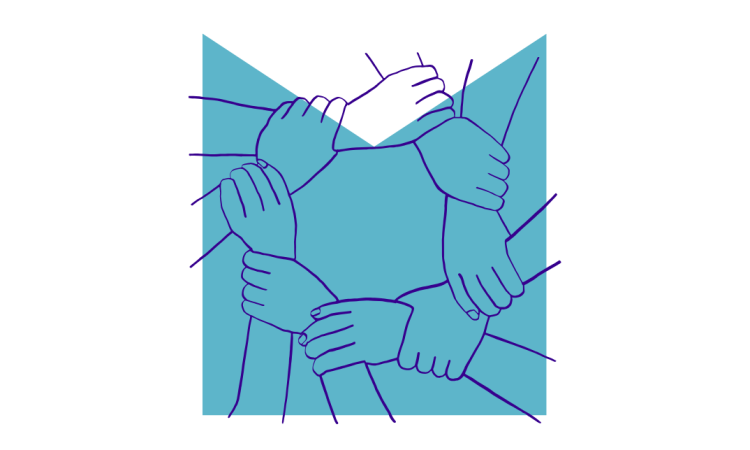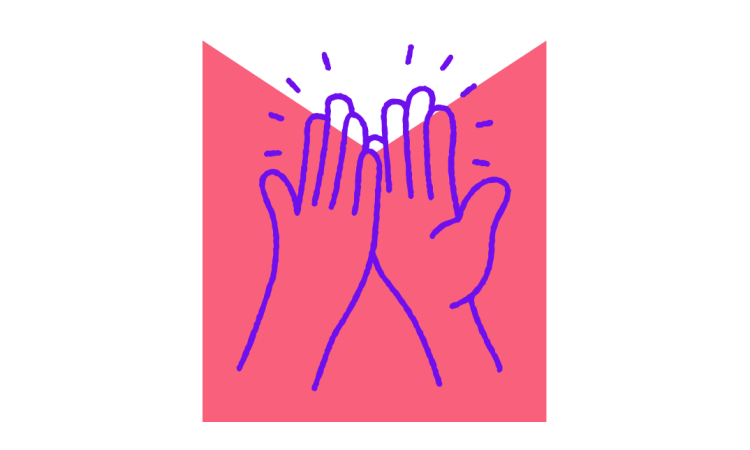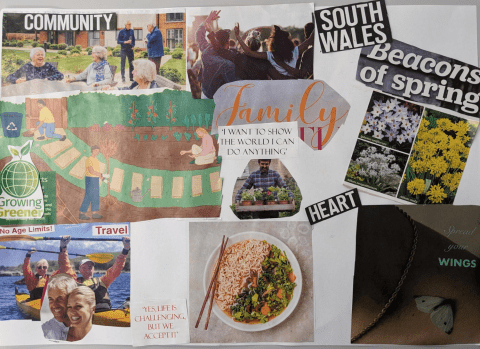It takes more than simply bringing people together to build a sense of community and belonging within a group. Read our blog to learn about how to foster positive community within groups that supports good mental health.
In my six years running groups with asylum seekers and refugees in Wales, I've learnt a lot about how to support individuals to grow their sense of community within their groups. I've seen firsthand how a sense of community can draw together individuals from a wide range of identities, cultures, and across languages. Positive community also helps to build a sense of belonging and purpose, which can support good mental health and wellbeing.

As part of the Bridges to Belonging project, we run Community Conversations on mental health for asylum seeking and refugee groups. Through this model, we support community groups to run 8 sessions that discuss mental health, and pair this with a creative or movement-based activity. Each session uses a variety of techniques that builds group member’s sense of shared community.
Based on my experience, here are some of those key components to fostering positive community, and some tips of how you might embed these within your groups.
Inclusivity
Inclusivity is about making everyone feel included. This is fundamental to building positive communities within groups. Everyone in the group can participate fully, and no one feels left out.
The group may include individuals from a diverse range of backgrounds, such as having different religions, race, sexuality and gender identity. Without inclusivity, it is impossible to build a sense of community within such diverse groups. Feeling able to take part and be supported by other group members allows individuals to truly engage with a group, and produces a sense of shared community.


Flexibility
A key way to ensure inclusivity in group settings is to actively consider the needs of group members, and to be responsive and flexible. This will allow you to ensure that everyone is able to participate. If there are language differences within the group, consider tailoring sessions. For example, if there are some with limited English language, you could consider including more activities that don’t need language, such as art or movement based.
It is also important to consider if changes need to be made to accommodate for disabilities. Not all disabilities are visible, so creating an inclusive environment is key to individuals feeling comfortable to disclose these, so that you are able to make any adjustments.
Group expectations
To feel able to engage in community, individuals must feel that the group is a safe space where they are able to be open about their identities without any risk. To build this kind of environment, it is crucial to make it clear that intolerance is not accepted and to make it clear that all are welcome, regardless of background.
Some groups add a pledge alongside their joining form which all members will read or sign. This could include something even as simple as “I agree to be welcoming to everyone in the group and I am aware that intolerance is not accepted here”. The purpose of this is to not only warn against intolerance, but allows those with marginalised identities to feel protected, and therefore safe to be open within the group. Groups might begin sessions by reminding of this pledge or their ground rules, particularly if there are discussions planned on relevant topics.


Lived experience
A crucial way to build community within groups, is ensuring that group members are involved within the group’s design and planning. This is especially important where group members have specific lived experiences, that allow them extra insight into the best ways of shaping the group.
Through utilising lived experiences, we ensure that the content of sessions and activities are relevant to group members. When lived experience is not listened to when creating or designing a group and its activities, we risk creating a non-inclusive and non-empowering space, which is out of touch with the life experiences of its members. Using lived experience voices to form groups empowers individuals to design spaces that fit diverse experiences of the world. Healthy communities are inclusive of diverse groups, and therefore lived experience is essential when considering building community in groups.
Peer support
Peer support is a powerful tool to create community through groups. Peer support is when people who have some overlapping experiences support each other. Feeling supported through other group members can create a sense of community, as well as promoting wellbeing.
Through our community conversations model, rather than presenting groups with a preset informational slideshow, we encourage our groups to discuss mental health topics. For example, instead of telling groups how to manage anxiety, we might start a discussion on “What tips might you suggest to a friend experiencing anxiety?”. Through questions like this, individuals are encouraged to come up with solutions that work for them, as well as practicing how they might share tips for mental health with the wider community.


Friendship and fun
Friendship and fun are key elements to build community within groups. Looking forward to seeing and spending time together encourages individuals to continue attending the group. Through continued attendance, individuals can grow stronger bonds and trust with other group members.
You can build this into your groups by including enjoyable activities that encourage individuals to get to know each other better, or to work together on something creative. In our community conversations sessions, one icebreaker activity we use involves group members not only sharing their name, but sharing the meaning of their name, and who gave it to them. By providing personal stories, group members get to know each other better, and become closer.
In our session on social support, we encourage building friendship through doing group art. In our latest session we asked teams of four to create a collage on “What does community mean to you?”. Here are some examples of what our teams created:
Positive community brings many mental health benefits, including a sense of belonging, safety and purpose. Whether you’re setting up a new group or already running one, and especially if you’re working with minoritised and marginalised groups, consider how you might embed these principles to help foster positive community.
How community benefits your mental health
Being part of a community can make life feel more meaningful and enjoyable, help us feel happier and safer, and improve our mental health. Read our 10 tips on how to get involved in your community.
Read our blog
Building community, supporting mental health: empowering asylum seekers and refugees
Coming together to share, collaborate, and create is a great way of building a sense of community to support the mental health of refugees and asylum seekers taking part in our projects in Scotland.
Finding safe and supportive communities as a trans or non-binary person
For transgender and non-binary people, supportive communities can enable their survival. Find out more about the important role this plays and ways you can make sure your own community is inclusive.
Mental Health Awareness Week
Since 2001, the Mental Health Foundation has been leading Mental Health Awareness Week - bringing the UK together to focus on getting good mental health. This year, the week takes place from 12 to 18 May 2025 and the theme is 'community'.
Find out more
Our work with refugees and asylum seekers
Bridges to Belonging
Bridges to Belonging is our peer support project for people seeking asylum and refugees in Northern Ireland and Wales. Using the Community Conversations model, we will increase mental health literacy and use the power of creativity to facilitate meaningful and supportive discussions amongst participant groups.
Elevate: amplifying the voices of refugees and asylum seekers
The 'Elevate' programme amplifies the voices of refugees and asylum seekers in decision-making processes across Scotland, and works to increase the understanding of their lived experience within key public bodies and third-sector organisations.

